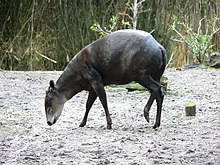Duiker
| Duikers Temporal range: Late Miocene to Recent
| |
|---|---|

| |
| Maxwell's Duiker, Cephalophus maxwellii | |
| Scientific classification | |
| Kingdom: | |
| Phylum: | |
| Class: | |
| Order: | |
| Family: | |
| Subfamily: | Cephalophinae Gray, 1871
|
| Genera | |
A duiker (/[invalid input: 'icon']ˈdaɪkər/) is any of about 21 small to medium-sized antelope species from the subfamily Cephalophinae native to Sub-Saharan Africa.

Duikers are shy and elusive creatures with a fondness for dense cover; most are forest dwellers and even the species living in more open areas are quick to disappear into thickets. Their name comes from the Dutch word for diver and refers to their practice of diving into tangles of shrubbery.
With a slightly arched body and the front legs a little shorter than the hind legs, they are well-shaped to penetrate thickets. They are primarily browsers rather than grazers, eating leaves, shoots, seeds, fruit, buds and bark, and often follow flocks of birds or troops of monkeys to take advantage of the fruit they drop. They supplement their diet with meat: duikers take insects and carrion from time to time, and even stalk and capture rodents or small birds. The Blue Duiker has a fondness for ants.
Species
- Subfamily Cephalophinae
- Genus Cephalophus
- Abbott's Duiker, Cephalophus spadix
- Ader's Duiker, Cephalophus adersi
- Bay Duiker, Cephalophus dorsalis
- Black Duiker, Cephalophus niger
- Black-fronted Duiker, Cephalophus nigrifrons
- Brooke's Duiker, Cephalophus brookei
- Harvey's Duiker, Cephalophus harveyi

Yellow-backed Duiker. - Jentink's Duiker, Cephalophus jentinki
- Ogilby's Duiker, Cephalophus ogilbyi
- Peters's Duiker, Cephalophus callipygus
- Red-flanked Duiker, Cephalophus rufilatus
- Red Forest Duiker, Cephalophus natalensis
- Ruwenzori Duiker, Cephalophus rubidis
- Weyns's Duiker, Cephalophus weynsi
- White-bellied Duiker, Cephalophus leucogaster
- Yellow-backed Duiker, Cephalophus silvicultor
- Zebra Duiker, Cephalophus zebra
- Genus Philantomba
- Blue Duiker, Philantomba monticola
- Maxwell's Duiker, Philantomba maxwellii
- Walter's Duiker, Philantomba walteri
- Genus Sylvicapra
- Common Duiker, Sylvicapra grimmia
- Genus Cephalophus
- Subfamily Cephalophinae
References
- Colyn, M. et al. 2010: Discovery of a new duiker species (Bovidae: Cephalophinae) from the Dahomey Gap, West Africa. Zootaxa, 2637: 1-30. Preview
select an article title from: Wikisource:1911 Encyclopædia Britannica

